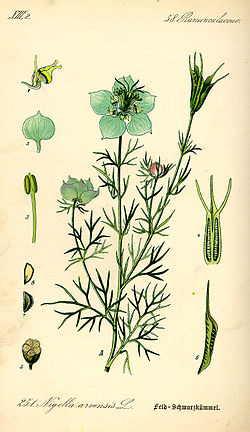| Nigella arvensis | |
|---|---|
 | |
| Scientific classification | |
| Kingdom: | Plantae |
| Clade: | Tracheophytes |
| Clade: | Angiosperms |
| Clade: | Eudicots |
| Order: | Ranunculales |
| Family: | Ranunculaceae |
| Genus: | Nigella |
| Species: | N. arvensis |
| Binomial name | |
| Nigella arvensis | |
| Synonyms [1] | |
List
| |
Nigella arvensis, the field nigella or wild fennel flower, is a species of flowering plant in the family Ranunculaceae. [2] It is native to North Africa, central, southern and eastern Europe, the Caucasus region, and the Middle East as far as Iran, and has gone extinct in Switzerland and Crete. [1] It is a minor crop, used locally as a substitute for Nigella sativa , black caraway. [3]


